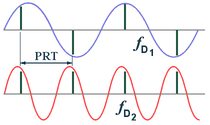Blind speed
The blind speed is a radial speed of the aircraft at which the phase shift of the echo signal from one pulse period to the next is 360 °. Targets that move at blind speeds are suppressed in the radar by an MTI circuit like fixed targets . The Doppler frequency arising at a blind speed is also blind frequency called.
When comparing two successive deflection periods, the case may arise that the target moves with a radial velocity which causes a phase shift of exactly 360 °. According to the periodicity of the sine function , this case can even occur with all integer multiples (± n • 360 °) of 360 °. Since the phase shift is also zero in these cases, the target is not recognized as a moving target. It flies at a blind speed and the MTI circuit will not be able to display it like a fixed target, which also has no phase difference between the pulse periods. A phase shift can only be measured if the pulse repetition frequency differs from the Doppler frequency. If the Doppler frequency is the same as the pulse repetition frequency , then all echo pulses have the same phase position and the aircraft flying at this speed appears as a fixed target. If the Doppler frequency is not equal to the pulse repetition frequency, the echo signal after the phase detector has a constantly alternating amplitude.
The blind speed depends on the transmission frequency of the radar device and its pulse repetition frequency.
- v Blind = one of the blind speeds
- λ = wavelength of the transmission frequency
- T s = pulse train period
The factor ½ in the formula results from the fact that with a radar the Doppler effect occurs practically twice: once on the way to the aircraft and again on the way back for the echo signal already affected by a Doppler frequency.
Simple measures against the occurrence of blind speeds are:
- Constant changing of the transmission frequency ( frequency diversity operation)
- constant changing of the pulse repetition frequency (staggered PRT)
With digital radar devices that work with the monopulse method, a staggered pulse repetition frequency is ineffective, since only one to a maximum of three transmission pulses are used to measure the coordinates of the target. These devices therefore inevitably use the frequency diversity method, i.e. transmit on two frequencies at the same time. A blind frequency can only occur on one transmission frequency. On the second transmission frequency, the target is then recognized with certainty as a moving target.


